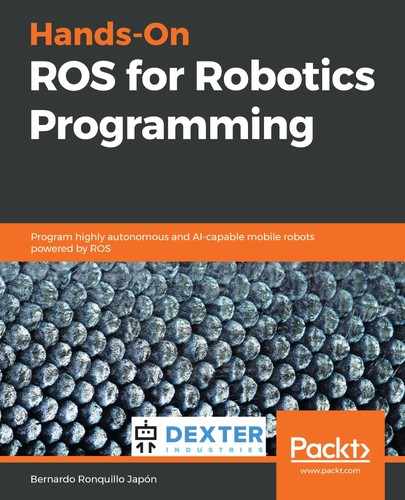Let's go one step back and use a minimal launch file to understand the syntax of these kinds of scripts:
$ roslaunch rviz_basics gopigoMinimal_rviz_simple.launch
As we saw with rosrun, the structure of the ROS command is very similar:
- First is the command name itself, roslaunch.
- Second is the package name, rviz_basics.
- The third is the script we will execute, gopigoMinimal_rviz_simple.launch.
The content of the gopigoMinimal_rviz_simple.launch file looks like this:
<launch>
<!-- set these parameters on Parameter Server -->
<param name="robot_description" textfile="$(find rviz_basics)/urdf/gopigoMinimal.urdf" />
<!-- Start 3 nodes: joint_state_publisher, robot_state_publisher and rviz -->
<!-- Send joint values -->
<node pkg="joint_state_publisher" type="joint_state_publisher" name="joint_state_publisher"/>
<!-- Combine joint values to TF-->
<node name="robot_state_publisher" pkg="robot_state_publisher" type="state_publisher"/>
<node name="rviz" pkg="rviz" type="rviz" args="-d $(find rviz_basics)/rviz/gopigoMinimal.rviz" required="true" />
</launch>
The syntax, in XML format, should be familiar to you. In this file, there are three types of tags:
- <launch> </launch>: Delimits the block of lines that are part of the roslaunch description.
- <node />: This is the sentence that's used to execute a ROS node. It is equivalent to the rosrun command that we explained in the previous chapter. Due to this, the equivalent command to a <node /> tagged line is as follows:
<node name="robot_state_publisher" pkg="robot_state_publisher" type="state_publisher"/>
is equivalent to...
$ rosrun robot_joint_state_publisher state_publisher
You can easily infer that the pkg attribute of the <node> tag is the package name and that the attribute type refers to the script that contains the code of this node.
- <param /> stands for parameter and is a new ROS concept. It contains a value that is stored in the ROS parameter server that you can visualize as the place where the robot's characterization is stored. A whole set of parameters defines a specific robot configuration. The ROS parameter server, as explained in the ROS official documentation (http://wiki.ros.org/Parameter%20Server), is as follows:
In our particular case, we have the following declaration in the launch file:
<param name="robot_description" textfile="$(find rviz_basics)/urdf/gopigoMinimal.urdf" />
The robot_description parameter is the path where the URDF file is stored. You will see that such a path contains an environment variable in the $(find rviz_basics) textfile attribute. This is a very nice feature that ROS provides out of the box so that you don't have to provide absolute or relative paths. The find command is applied to the rviz_basics package and returns the absolute path of the package, that is, ~/catkin_ws/src/book/Chapter4_RViz_basics. The $ sign means the value of, in the same way as you would do for system environment variables.
